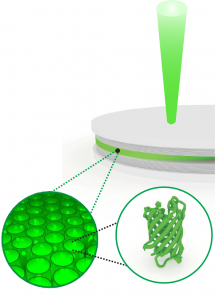We have been fascinated by fluorescent proteins and by their amazing optical performance for quite a while now. In 2011, we reported lasing from fluorescent protein and from cells producing them. Later, we showed that unlike most synthetic dyes, fluorescent proteins do not suffer from concentration quenching which is a direct result of their unique molecular structure.
 Now Christof Dietrich — together with a number of people in our group and with Prof Sven Höfling as well as with support from Kai Ostermann at TU Dresden — has demonstrated the first polariton laser based on fluorescent proteins. We find that fluorescent proteins provide an excellent solution to the conundrum of tight exciton binding versus bi-molecular recombination. By combining the advantages offered by the molecular structure of the protein with a simple approach for preparing solid state films of protein inside an optical cavity, we demonstrate polariton lasing at room temperature and under conventional nanosecond pumping (i.e. relaxing earlier restrictions on pulse duration by 1000-fold). See the whole story on the Science Advances website.
Now Christof Dietrich — together with a number of people in our group and with Prof Sven Höfling as well as with support from Kai Ostermann at TU Dresden — has demonstrated the first polariton laser based on fluorescent proteins. We find that fluorescent proteins provide an excellent solution to the conundrum of tight exciton binding versus bi-molecular recombination. By combining the advantages offered by the molecular structure of the protein with a simple approach for preparing solid state films of protein inside an optical cavity, we demonstrate polariton lasing at room temperature and under conventional nanosecond pumping (i.e. relaxing earlier restrictions on pulse duration by 1000-fold). See the whole story on the Science Advances website.
